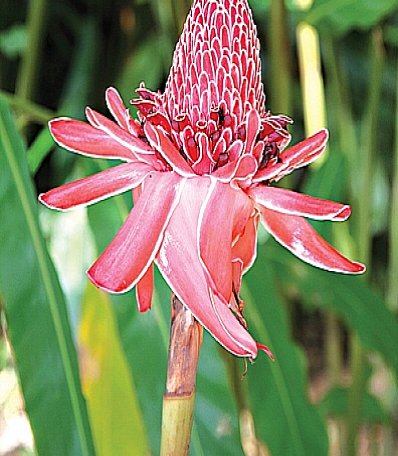Phuket gardening: Vistas of paradise

PHUKET: It is always a great pleasure to be invited to a Phuket home, and to be asked for advice about aspects of the garden. This week’s visit proved predictably pleasurable and the upshot, hardly surprising – was a decision to write about the experience.
The original intention had been to advise about pot plants but, as often happens on these occasions, it turned into a discussion about many aspects of an ongoing horticultural projects.
This is no run-of-the-mill property. Perched on a precipitous hillside, and with panoramic views over Chalong Bay, the newly built, four storey terraced property literally follows the contours of the ravine. Flanked by walls on each side, the structure forms three sides of a rectangle with a central, shaded area open to the sky.
All three balconies face the ultramarine waters of the island dotted bay, the lowest terrace home to a swimming pool, and the two upper patios paved with pleasant terracotta tiles.
Here, said my guide, is where we start. He pointed to huge, sculptural clay pots which matched the floor and which flanked the white front walls. I always think it’s a good idea to have more than one kind of inhabitant in large containers; here tall wrightia religiosas at the center of each pot were flanked by white flowering ixoras. Both are evergreen shrubs and both were in flower, with the pendulous blooms of the wrightia delivering their sweet fragrance. But more pots were required to form a colorful screen across the front of the two balconies. And obviously shrubs able to take the noon-day glare would be needed.
Suggestions included Crown of Thorns (euphorbias), available in cerise, white and salmon pink and in large and small flowering cultivars, and Desert Rose (adeniums), which can now be found in beautiful shades of brilliant red as well as deep pink. These are reliable, year round bloomers, require little attention and do well in pots. The only snag is that they are slow-glowing, so you might want to either put several in one pot, or add plants such as ixoras, or variegated foliage plants such as Crotons (codiaeum) which come in a huge range of color combinations. The Umbrella Tree (Schefflera) is one tough cookie, and looks great in a pot, as does Orange Jasmine (murraya paniculata) with its strongly scented white flowers.
On the lower terrace were a number of potted golden cane palms. A few were going brownish-yellow before their time, the victims of over-zealous watering. Better dried out or transplanted to the main garden.
The actual garden is on a steep slope with forty or fifty steps from top to bottom, and high walls to mark the boundaries on each side. So the original garden designer sensibly chose trees and shrubs that could cope with limited sun and moisture, and with Phuket soil that is thin and lacking nutrients. Some plantings have been real success stories: there are numerous fish-tail and wine palms, to provide a verdant screen down both sides of the property, with huge hanging, beaded inflorescences like chain mail.
Lower down are several elegant foxtail palms, and the attractive green foliage of Lady Palms (rhapsis). Other large trees enjoying the sea-air are calabashes: their open habit allows shrubs – heliconias, for example – to flourish beneath., These include several exotic cultivars such as collinsiana. Zingibers are represented not only by a bed of Costus near the access road, but by the striking torch ginger (etlingera elatior) with its massive waxy red bracts. An exciting sight in Phuket.
The central area is surrounded by high walls on three sides. Devoid of much sunlight, with little top soil and sloping precipitously, it presents a real challenge. At the moist base, a row of dark green foliage plants are doing well, but the whole area would benefit from terracing of low stone or natural brick walls to retain both moisture and the soil amendments – top soil, compost and fertilizer – which need to be added.
Then you can begin to think about installing shade loving plants: ferns such as asplenium, aglaonemas, philodendron, and anthuriums.
Then you have the property that has everything.
Tip of the week – Growing annuals
Annuals germinate, grow, set seed and die, all within the course of a year, thereby providing a splash of rapid and vivid color They are normally grown from seed. You can collect your own seeds when you dead-head flowers (which encourages more flowering), but ensure that the seeds are dry and fully mature.
Annuals you might consider in Phuket include cockscomb (celosias), cosmos daisies, sunflowers (helianthus), and African marigolds (tagetes). Some can be bought as packeted seeds, and should be sown either in prepared open ground, or better still in containers where their progress can be monitored. You can also buy annuals in small pots which you should water thoroughly.
Keep the soil moist, but not soggy: annuals have shallow root systems, but because they grow quickly, they need moisture and nutrients.
Personal favorites include zinnias, magenta globe amaranths (gomphrena globosa) and the low-growing and multi-hued rose moss (portulaca).
Phuket Gardening is Phuket Gazette columnist Patrick Campbell’s feature of all things flora.
If you have a question or a garden that you would like featured, you can email Patrick Campbell here.
Keep checking our online Phuket Lifestyle pages for regular gardening features and tips.
— Patrick Campbell
Latest Thailand News
Follow The Thaiger on Google News:


























